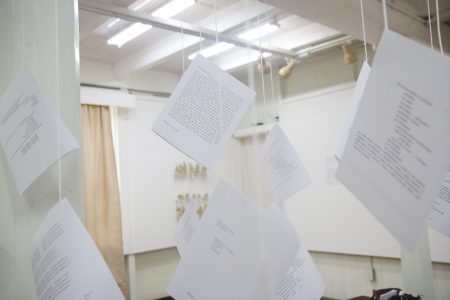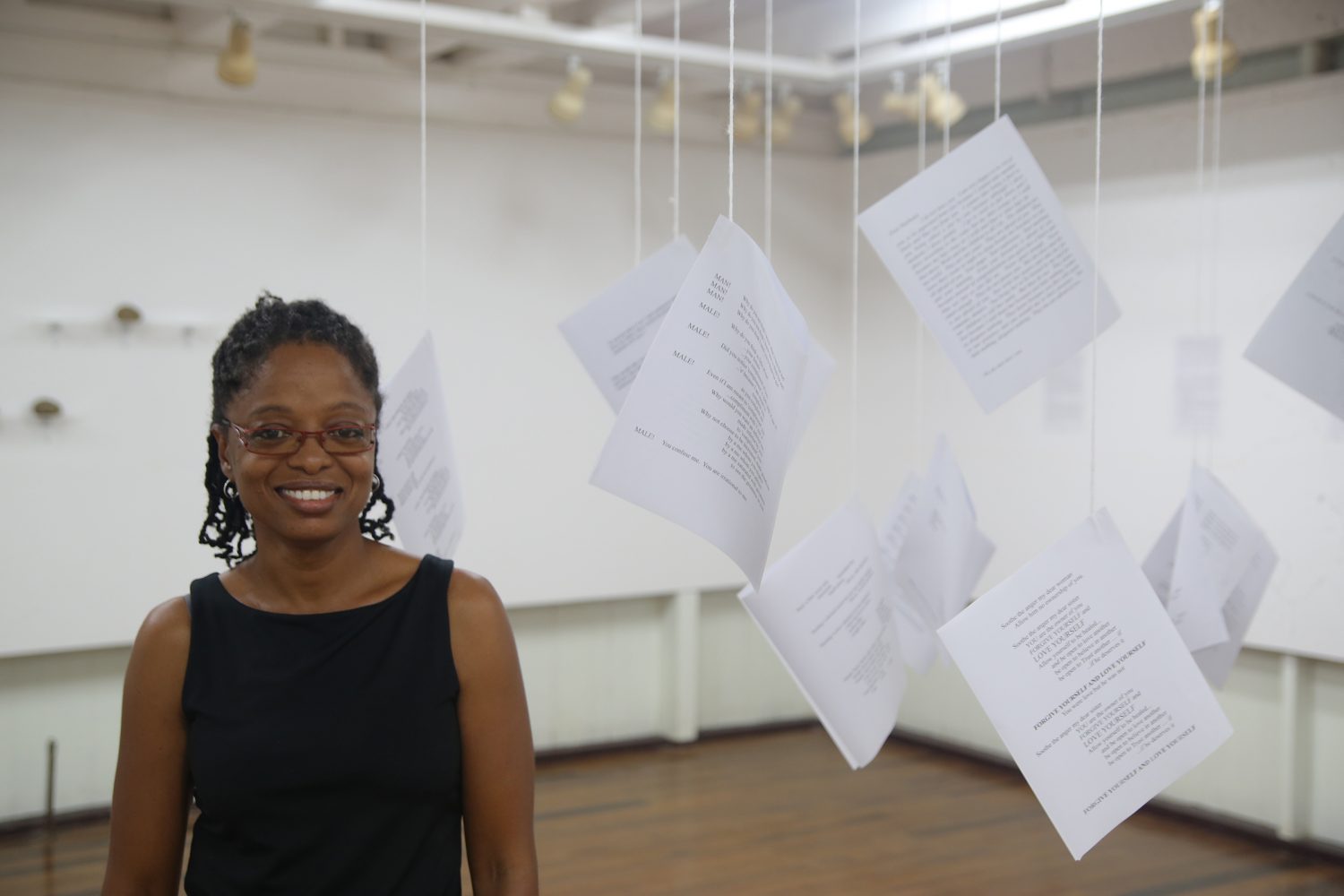Having felt, witnessed, and heard of violence against women in all forms, Akima McPherson decided to address the issue that destroys women every day, whether by death, emotionally, psychologically or even spiritually.
But it is not just the violence she addresses but all issues that women face, things that are considered normative that ought not to be.
“I have to find a way of speaking about these things without being crass, but I want us to really take stock because we are culturalising our girls in these kinds of ways, so the cycle perpetuates itself,” McPherson told the Sunday Stabroek in a recent interview, adding that it is worse with the popular culture from North America and the Caribbean being made part of the society.

And she did not choose the orthodox path in speaking to this issue but rather she decided to use art. And for one to really understand the messages coming out of what she paints, writes, makes or assembles they have to spend time not only feeling and seeing but also listening.
The University of Guyana lecturer for over 10 years uses visual arts which involves ceramics, drawing, painting, sculpture, printmaking, design, crafts, photography, video, filmmaking, and architecture.
She explained that while her work does not always intersect with easy commodification, the material she uses is relevant to co-communicate the ideas and messages. She has written messages on plastic which does not have a long shelf life, but she wanted to echo the invisibility of the women whose messages she communicated and also to remind that they “maybe in our midst but we are not aware.”
At present, she is telling the story of an abused Jasmine who finally walked away from her abusive relationship in an art installation at the Castellani House. The installation comes to an end on January 13. An art installation is an artistic genre of three-dimensional works that often are site-specific and designed to transform the perception of a space.
Her present installation that chronicles the journey of Jasmine, apart from painting and words on paper, also uses unfired clay, which is not durable and is fragile which informs viewers of how fragile Jasmine and other women in her situation are. As she puts it, she is very “deliberate in my material choices.”
The installation is entitled ‘Walk with me’ which is the bringing together of five different body of works that are part of the series ‘Walk with me.’ ‘Walk with me’ 111 was a multimedia installation with video, Walk with me IV is Jasmine’s story told in text fomr, Walk with me V was in the form of suspended text and Walk with me V1 which was about overcoming was done in sculpture form. While parts 111, V and VI of the series have already been held, McPherson said, series IV, of which the others also form part, is now being held as it was one of the more difficult parts. The current installation also involves work from a previous series titled ‘Moodscape/Introspection’.
In the installation, with the exception of one coloured painting, everything is white because McPherson said she wanted persons to feel a “sort of material peacefulness within that space.” As the story of Jasmine is being read and it becomes difficult, the viewers will hear the calming and meditative voice of a woman narrating her own journey of experiencing violence and how she used education to walk away. That woman’s face is not shown but there is a video of her hand movement as she speaks for 17 minutes. It is not also expected that persons read the entire story. McPherson put different sections in bold and those give the gist of the story.
Women and violence
McPherson, who is also a graduate of the University of Guyana and the Burrowes School of Art, said she began getting interested in women’s issues particularly as they relate to violence against women and girls and to reflect it in a direct and obvious ways in 2011 while she was a Commonwealth Scholar and was pursuing Masters studies in Art and Space at the Kingston University in London.
“I had gone off to do Masters studies because I was interested in exploring ways and means to make the subtle statements I was making that were of social relevance be more obvious and more direct to speak to an audience. Because up until then I found that the work that I was doing, not only were the themes a bit unacceptable, but visually the format as a painting, people were really not understanding what I was doing,” the artist admitted.
At that time, she started looking at and practicing the Hindu-inspired Chakra practice and through her studies she realized that there was a connection between Hinduism and Christianity. She saw a platform for a more socially cohesive situation in Guyana as opposed to the conflict between the two numerically dominant groups – Indians and Africans.
She said she was trying to bring this out in her work even though it was difficult for her audience to relate to. It was during her studies that she got the opportunity to do some work on a social issue that mattered to her and she focused on the violence being meted out to women and girls experienced in the Democratic Republic of Congo (DRC).
During her research she realized the element of rape against women and girls wherever there is a war, even in the refugee camps was pervasive and she wanted to talk about it and also to look at ways and means to address it. Part of her thesis also looked at art involving itself in sociopolitical struggles and she recognised that she needed to learn from artists who would have taken the route before as in Guyana artists typically make reference to nationalistic issues and deal with culture but infrequently deal with social issues.
She returned to Guyana with the intention of continuing the conversation on the DRC, which had seen interest on her campus when she hosted her exhibition highlighting the issue. She continued her work on this subject as means of transitioning to what happens in Guyana.
Her body of work addressing the DRC crisis was under the name ‘The Mukwegee’ after Dr Denis Mukwege who had set up the Panzi Hospital where women and girls who cannot afford post-rape medical care are treated without charge.
Following this, she started the ‘Walk With Me’ series all of which addressed women’s issues, moreso violence against women. The Jasmine story is the most direct attempt by McPherson to address the violence. In that story the woman is attacked, and it speaks to the aftermath of her attack in terms of seeking medical attention and being evasive about what had happened. She eventually told the truth and the story also details her separation from her attacker. The story also speaks to women who are in similar situations who financially can leave their abusive partners but remain. The artist said she wanted them to understand that they should walk away from the violent situations and that the one attack can be the stepping stone to many others.
“We often hear stories of women who cannot walk away because of their financial situations, they have to live with the person, they have children with the person. But what about those other women who stay in relationships for other reasons and many times they are not talked about,” McPherson noted.
In the story, McPherson said, there is questioning on Jasmine’s part as to whether her partner meant to attack her and a slow realisation that he must have known what he was doing.
“I wanted to empower women that yes you may have all of these questions, but you needed to walk away. And it wasn’t easy for Jasmine, she did linger, she did wait around looking for explanations that never came. But she was always fearful that it could escalate and ultimately she realised that in staying the next time she could be meeting her maker.”
The story is real, but McPherson said she needed to protect the identity of the woman but not so much the man and as such it took a while for her to bring the story to the public.
Over the years, people shared stories, she had observed and read things all of which form part of the series that address issues of violence against women. She also vented in a journal, excerpts of which formed part of the exhibitions. It also addresses the issue of releasing the anger.
“The journal was a spontaneous outburst over several weeks,” she explained.
‘Timidly’
While she began her frontal addressing of the issues that face women, which include gender-based discrimination which she has experienced during her years of employment, McPherson said that she began it subtly following her return to Guyana as a young adult after she had lived away for many years.
Following her graduation from the University of Guyana she started to “timidly” address women’s ownership of their sexuality.
“In Guyana girls must sit and be nice and all Victorian while the men have all the fun and women’s sexual urges get shut down. And I don’t know where I got the balls from to really talk about it… I put it in the painting but I wasn’t telling people what I was doing still,” she admitted.
Her work was also a form of trying to heal herself from “rude awakenings” she got from the pressures she felt being a female in Guyana. This includes that the constant sexual harassment on the streets, where women are told what men would like to do with them in the bedroom or how sexy a particular part of their anatomy looks and when they do not respond they are verbally abused.
McPherson said while addressing women’s issues will not be her only subject matter in speaking through her art as it is draining, she will continue to speak as she feels the need to continue.
She also wants to advance visual arts, as for her in Guyana there is not enough appreciation for this art form as many persons have limited understanding of it.





